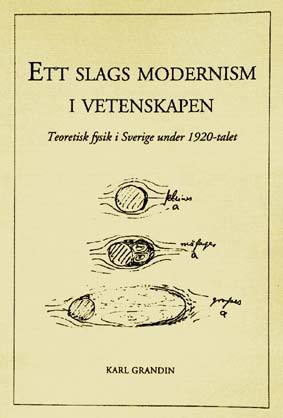Karl Grandin, Ett
slags modernism i vetenskapen: Teoretisk fysik i Sverige under 1920-talet,
Institutionen för idé- och lärdomshistoria, Uppsala universitet, Skrifter, nr 22
(Uppsala, 1999). Limbunden, 244pp. Pris 150:- kr.
 |
Om bokens
titel:
"Den modernaste mekaniken kan räkna sin upprinnelse från
vågteorien för atomerna, och med dennas dunkla utgångspunkter har följt
ett slags modernism i vetenskapen. I den klassiska mekaniken har man
laborerat med klara utgångspunkter och stränga matematiska deduktioner. Nu
äro vi inne i en period, där hypoteserna sakna åskådlighet och f. ö.
oupphörligt avlösa varandra i hastigt tempo, den ena vildare än den andra.
Och den matematiska behandlingen gör intryck av det sublimaste godtycke."
Citat från: Henrik Petrini, "Determinism eller indeterminism", Religion
och Kultur 1 (1930), sid 107. |
Bokens
omslagsillustration:
I den omoderna virveln -- Teckningarna på omslaget
illustrerar flödet kring en cylinder, där strömningen successivt ökar. Bilderna
är gjorda av Ludwig Prandtl och återfinns i ett brev till den svenske fysikern
C.W. Oseen. I deras brevväxling försökte de komma underfund med skillnaderna
mellan sina respektive hydrodynamiska teorier. Källa: Ludwig Prandtl till C.W.
Oseen, 14/5 1919, Oseenska familjearkivet, Enskilda arkiv 238, Landsarkivet i
Lund.
Abstract in
English
This dissertation
considers the development of theoretical physics in Sweden in the 1920s. During
this decade, the emphasis of the research in the theoretical physics departments
of the Swedish universities changed from hydrodynamics to theoretical atomic
physics. Research in hydrodynamics continued, but henceforth it was mainly
conducted at the Technical College in Stockholm, which, during this time, was
fully occupied with developing its own research programme. This development took
place through discussion, debate and strategic judgement.
This development is
investigated in terms of theoretical and experimental physics cultures, as well
as through the study of "theoretical technologies" and theoretical techniques.
By applying these concepts it is easier to understand the developments and to
formulate pertinent questions. Hydrodynamics constituted a theoretical
technology where the education, the theoretical tools and the traditions for
posing and dealing with problems provided the framework for the theoretical
work.
Four case studies have
been made, each of the first three are centered on one main character, whilst
the fourth study includes them all. C. W. Oseen is investigated first. His
research was devoted almost exclusively to hydrodynamics, although he was well
inclined towards, though critical of, the new physics. From the central position
he occupied within Swedish physics, he was also to judge the new physics, partly
as an expert at professorial appointments and partly through the evaluation work
within the Nobel physics committee. Oskar Klein and Ivar Waller both belong to
the first generation of Swedish theoretical physicists to concentrate their work
on the new theoretical physics, but they followed different directions. In the
last case study there are examples of how a decision was finally made in favor
of the new physics, in connection with the appointment of a professor in
Stockholm, and in connection with the Nobel Prize evaluations. In this way the
focus of the theoretical physics came to be changed.
Innehåll
Förord
1.
INLEDNING
Bakgrund
Forskningsläge
Problem
och metod
2. CARL WILHELM
OSEEN
Hydrodynamiken
Verkliga
viskösa vätskor
Gränsövergång eller gränsläger: Oseen och
Prandtl
En stadig lokal
-- det teoretiska laboratoriet
Den nya
fysiken
Kontakten med Bohr
Konferenser, akademier och
kommittéer
Etervindar -- relativitetsteorin i blåsväder
Den nya
kvantfysiken
Sammanfattning
3. OSKAR
KLEIN
Från Arrhenius
till Bohr
Mera förstånd på kvantteori:
Bohr via Kramers
Neutral konferens i Lund
Köpenhamn och Lund
Ann
Arbor
Den nya
fysiken
Komplementariteten
Köpenhamnskonferensen
1929
Sammanfattning
4. IVAR
WALLER
Den ambulerande
docenten
Docenttjänstgöring
Sammanfattning
5. MATEMATISK ELLER
TEORETISK FYSIK?
Professuren i
Stockholm 1930
Nobelkommittén
och den nya fysiken
Slutsatser
Epilog
Summary
Källor och
litteratur
Personförteckning
